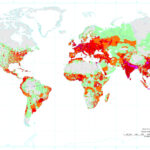We explain what population density is and how it is calculated. In addition, the factors that affect the distribution of the population and the countries and cities with the highest density of inhabitants.

What is population density?
The population density is number of inhabitants per square kilometer living in a given territory.
Numerous factors influence the population density of a region, such as its relief (plains and lowlands tend to be much more densely populated than mountains and highlands), its climate (temperate climates take precedence over extremes) and its availability of resources. .
Likewise, there are political (stability, social peace), historical (cities that have been populated for centuries), cultural (cities that are important religious centers) and economic (work, access to goods and services) considerations that influence the preferences of the population at the time of distribution.
How is population density calculated? The calculation of population density consists of dividing the total number of people who inhabit a given territory by the surface of the populated area (expressed in km2):
Population density = Number of inhabitants / Area in km2
Therefore, density is expressed in inhabitants per square kilometer (inhabitants/km2). For example: the population density of Canada is 4.05 inhabitants/km2.
Frequently asked questions
What is population density?
Population density is the average number of people living in a territory per square kilometer.
How is population density calculated?
Population density is calculated by dividing the number of people living in a territory by the surface of the inhabited area.
What are the most densely populated cities in the world?
Some of the most densely populated cities in the world are Manila (Philippines), Mumbai (India) and Dhaka (Bangladesh). These cities exceed 70,000 inhabitants per square kilometer.
What is the least densely populated country in the world?
The least densely populated country in the world is Mongolia, with 2.17 inhabitants per square kilometer.
What factors influence population density?
The way in which people are distributed in the world is a phenomenon that is influenced by multiple factors:
- Geophysical factors. Areas with temperate climates, fertile soils, and abundant water resources tend to be more attractive for human settlement. In contrast, regions with extreme climates such as deserts, tundra or mountainous areas present less favorable conditions for human life, resulting in low population density.
- Historical and cultural factors. Areas that throughout history have been important centers of trade, capitals of empires, places of religious relevance or axes of routes continue to be, in general, more densely populated places.
- Economic factors. Areas with dynamic economies, greater job opportunities, and industrial development tend to attract more people. Large cities and their metropolitan areas have a high population density due to the concentration of employment possibilities.
- Political and social factors. Armed conflicts and political instability can lead to massive displacements of people and affect population density in certain places. Migrations and birth control policies, such as those implemented in China with the one-child policy starting in 1980, also have an impact on population distribution and density.
Countries with higher and lower population density

The most densely populated countries in the world are typically small nations or island states with relatively large populations compared to their size. According to its population and area, Monaco tops the list of countries with the highest population density with approximately 19,000 inhabitants/km2.
It follows Singapore in Southeast Asia, with around 7,600 inhabitants/km2. Bahrain, Vatican City and Maldives They are also among the countries with the highest population density, with figures ranging between 1,700 and 1,910 inhabitants/km.2.
Other countries with high population density are Malta, Bangladesh, Lebanon, Barbados and Mauritius.
On the other hand, among the countries with the lowest population density are Mongolia, with 2.19 inhabitants/km2; Namibia, with 3.15 inhabitants/km2and Australia, with 3.37 inhabitants/km2.
Cities with the highest population density
The most densely populated cities in the world are characterized by a large concentration of people in relatively small areas. This can be seen especially in some Asian cities, where the combination of economic, social and geographical factors has driven rapid urban growth, particularly in recent decades.
Among the cities with the highest population density are Manila, Pateros and Mandaluyong in the Philippines, Mumbai in India and Dhaka in Bangladesh. These cities, with densities that exceed 70,000 inhabitants/km2attract people because of their wide range of job opportunities, but at the same time they have an urban infrastructure that does not always meet the needs of the growing population.
In many cases, cities with high population density such as Port-au-Prince in Haiti or Lagos in Nigeria They face severe urban and social problems, such as housing shortages, traffic problems and considerable pressure on water and energy supplies. For this reason, in these cities many people live without drinking water, without electricity and without heating.
Other very densely populated cities, such as Hong Kong present a strong urban duality: on the one hand, they are centers of economic and cultural dynamism, but on the other hand they face major problems of pollution and social inequality.
document.addEventListener(“DOMContentLoaded”, (e) => {
var sliderContainer, slider;
sliderContainer = document.getElementById(‘block_d872aa93c1ff06a4ab856548a44c8e9b’);
if (typeof initSlider !== ‘function’) {
console.log(‘Swiper haven\’t been loaded’);
sliderContainer.className += ‘ fw scroll-snap’;
return;
};
options = {
direction: ‘horizontal’,
speed: 1000,
slidesPerView: ‘auto’,
// slidesPerGroup: 1,
centerInsufficientSlides: true,
// centeredSlides:true,
spaceBetween: 15,
breakpoints: {
720: {
// centeredSlides: false,
// slidesPerGroup: 2,
spaceBetween: 25
},
},
pagination: {
el: ‘.swiper-pagination’,
type: ‘bullets’,
clickable: true
},
}
slider = initSlider(sliderContainer, options);
})
References
- Azun, L. (2024). The 20 most populated cities in the world in 2024. National Geographic Spain.
- https://viajes.nationalgeographic.com.es/
- Martínez, R. (2022). What are the countries with the highest population density? Highway. https://www.autopista.es/
- Ritchie, H. and Mathieu, E. (2019). Which Countries Are Most Densely Populated?. Our World in Data. https://ourworldindata.org/





